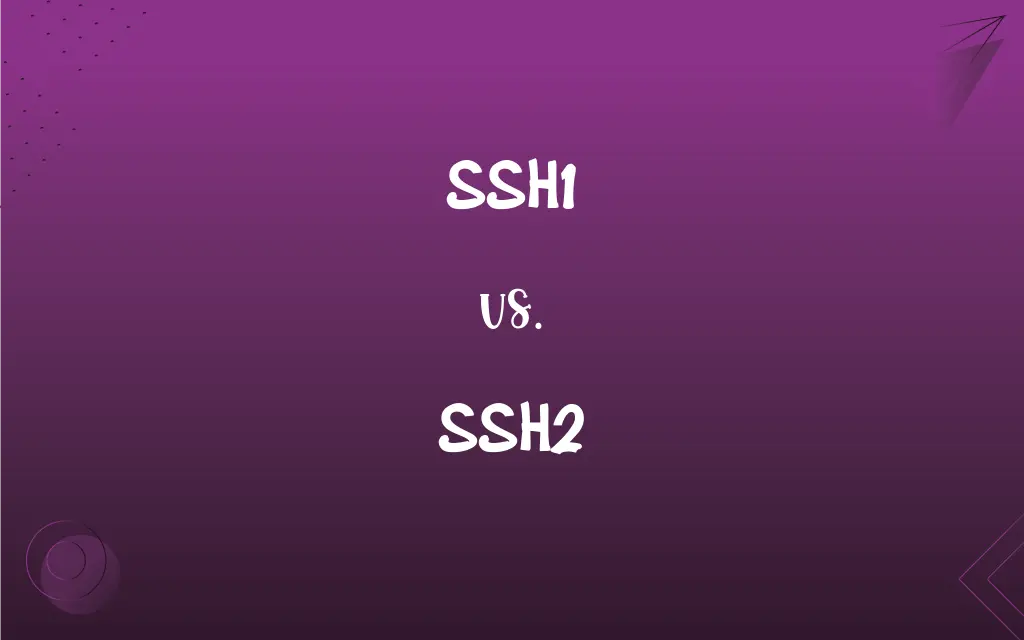SSH1 vs. SSH2: What's the Difference?
Edited by Aimie Carlson || By Janet White || Published on March 24, 2024
SSH1 is the original version of the Secure Shell protocol, vulnerable and outdated, while SSH2 is its more secure, widely adopted revision.

Key Differences
SSH1, the first version of the Secure Shell protocol, was designed for secure remote login and other secure network services over an insecure network. SSH2, a more secure revision, introduced to address vulnerabilities and limitations found in SSH1, has become the standard. Each line in the following paragraphs discusses SSH1 and SSH2 independently, without connecting one paragraph to another.
SSH1 provided a foundation for secure communications, but it was soon discovered to have significant security flaws. SSH2, developed to overcome these flaws, introduced improved security features, including more robust cryptographic algorithms. SSH1's architecture was simpler, making it easier to implement but less flexible and secure compared to SSH2's more complex, modular design.
One of the critical issues with SSH1 was its vulnerability to man-in-the-middle attacks, prompting the development of SSH2 with enhanced authentication mechanisms. SSH2 supports several cryptographic algorithms, allowing it to be more adaptable to different security requirements and environments. While SSH1 was groundbreaking for its time, SSH2's introduction marked a significant advancement in secure communications protocols.
SSH1's single, monolithic protocol design contrasts with SSH2's layered architecture, which separates key exchange, authentication, and connection protocols. This separation in SSH2 allows for more straightforward updates and better security management. Despite SSH1's historical importance, SSH2's superior security and features have led to its widespread adoption, effectively making SSH1 obsolete.
The continued use of SSH1 poses significant security risks, and it is generally recommended to use SSH2 for all secure shell communications. SSH2's compatibility with newer encryption technologies and its ongoing updates ensure it remains secure against evolving threats, unlike SSH1, which has been largely abandoned due to its insecurities.
ADVERTISEMENT
Comparison Chart
Security
Vulnerable to certain attacks, less secure.
More secure, with robust encryption methods.
Architecture
Monolithic, single protocol design.
Modular, with separate layers for different functions.
Cryptographic Algorithms
Limited options, weaker algorithms.
Supports multiple, stronger algorithms.
Vulnerabilities
Susceptible to man-in-the-middle attacks.
Designed to prevent such vulnerabilities.
Adoption and Use
Obsolete, not recommended due to security risks.
Widely adopted, considered the standard for secure shell communications.
ADVERTISEMENT
SSH1 and SSH2 Definitions
SSH1
Designed for secure remote login, file transfer, and port forwarding.
Our old system relied on SSH1 for secure file transfers.
SSH2
Designed to address vulnerabilities found in SSH1.
SSH2 was developed to overcome the shortcomings of SSH1.
SSH1
Initial version of the Secure Shell protocol for encrypted network communication.
I used SSH1 for remote access before it was deemed insecure.
SSH2
Modular design allows for separate authentication, connection protocols.
The modular design of SSH2 simplifies security management.
SSH1
Not recommended for use due to outdated security features.
We had to upgrade from SSH1 to ensure secure connections.
SSH2
Revised version of Secure Shell with enhanced security features.
We transitioned to SSH2 for its improved security protocols.
SSH1
Known for its simplicity but had significant security vulnerabilities.
SSH1's simplicity made it popular, despite its vulnerabilities.
SSH2
Supports multiple encryption algorithms for increased security.
SSH2's support for various encryption algorithms makes it versatile.
SSH1
Lacks support for modern cryptographic standards.
SSH1 couldn't keep up with new encryption methods.
SSH2
Widely adopted as the standard for secure network communications.
SSH2 is now the industry standard for secure remote logins.
FAQs
What is SSH2?
An improved version of SSH with enhanced security features.
What cryptographic algorithms does SSH2 support?
Multiple, including AES, 3DES, and RSA.
Why was SSH2 developed?
To address security vulnerabilities in SSH1.
What is SSH1?
The original version of the Secure Shell protocol for secure network services.
What are the main security concerns with SSH1?
Vulnerabilities like man-in-the-middle attacks.
Can SSH1 and SSH2 interoperate?
Generally, no, due to significant differences in their protocols.
Are SSH1 and SSH2 compatible with all operating systems?
Most modern systems support SSH2, but SSH1 support is rare and not recommended.
Is it easy to upgrade from SSH1 to SSH2?
It requires updating software and possibly configurations, but it's essential for security.
Are there any situations where SSH1 might still be used?
Its use is not recommended under any circumstances due to security vulnerabilities.
How does SSH2 improve security over SSH1?
Through stronger encryption algorithms and a more secure architecture.
Is SSH1 still in use?
Its use is strongly discouraged due to security risks.
How do the authentication methods differ between SSH1 and SSH2?
SSH2 offers more secure and diverse authentication methods.
Why is SSH2 preferred over SSH1?
Due to its superior security and flexibility.
Can SSH2 be used for the same purposes as SSH1?
Yes, for secure remote login, file transfer, and more, but with enhanced security.
What led to the decline in SSH1 usage?
Discovery of significant security flaws.
Do all SSH clients and servers support SSH2?
Most modern SSH implementations support SSH2.
What should be done if an application only supports SSH1?
It's critical to update or replace such applications to ensure secure communications using SSH2.
Can SSH2 address all security issues found in SSH1?
It addresses known SSH1 vulnerabilities but requires proper configuration and maintenance for ongoing security.
What happens if you try to connect to an SSH2 server with an SSH1 client?
The connection will generally fail due to protocol incompatibility.
How does the architecture differ between SSH1 and SSH2?
SSH1 has a monolithic design, while SSH2 is modular.
About Author
Written by
Janet WhiteJanet White has been an esteemed writer and blogger for Difference Wiki. Holding a Master's degree in Science and Medical Journalism from the prestigious Boston University, she has consistently demonstrated her expertise and passion for her field. When she's not immersed in her work, Janet relishes her time exercising, delving into a good book, and cherishing moments with friends and family.
Edited by
Aimie CarlsonAimie Carlson, holding a master's degree in English literature, is a fervent English language enthusiast. She lends her writing talents to Difference Wiki, a prominent website that specializes in comparisons, offering readers insightful analyses that both captivate and inform.































































